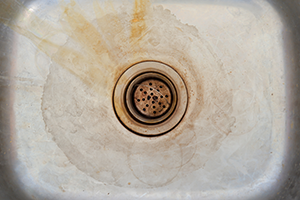Stains on Plumbing Fixtures
What causes discoloration on sinks, tubs, and toilets?
If the stains or water are blue-green in color, then most likely, corrosion of copper is occurring within the household plumbing. Stains that are various shades of yellow, tan, brown, black, orange, or red can indicate the presence of metals other than copper.

Two other metals that are typically to blame for staining are iron and manganese. While these minerals serve as essential nutrients for your body, they aren’t so kind to plumbing fixtures, appliances and even clothing. Reddish and yellow-tan discoloration is often caused by iron, while black or dark brown discoloration points to manganese. Due to their similarities and their frequent occurrence in tandem, iron and manganese are generally treated in much the same way.
Discoloration usually results from the exposure of these metals to oxygen, known as oxidation. In your plumbing, water often has limited exposure to oxygen, keeping any soluble (ferrous) iron or manganese in solution. Once these metals come out of a faucet and are exposed to the air, oxidation occurs and chemical reactions may cause them to form a substance that creates visible staining.
Staining may result from water with very low concentrations of these metals: 0.3 parts per million (ppm) of iron or 0.05 ppm of manganese. This is why water that leaves stains on plumbing fixtures may appear clear when coming out of the tap.
Some specific kinds of bacteria, which can cause discoloration, thrive in iron- and manganese-rich water. While these bacteria may not be harmful to the human body, they can clog pipes and affect flow rates in a home’s plumbing and appliances.
Water treatment can address staining issues.
Stains resulting from metals, tannins or any other contaminant will affect fixtures and appliances found throughout the entire home or business. For this reason, contaminants causing stains are typically addressed with water treatment for the whole house or building rather than just at a specific faucet. Contaminants that stain can be reduced in water by using one of the following means:
- Anion Exchange
- Activated Carbon
- Filtration
- Chlorination
- Reverse Osmosis
- Distillation
- Ozonation
Click here to find a water treatment provider who can help.
Click here to find products certified by WQA for the reduction of stain-causing contaminants such as iron, manganese, or copper (certified to NSF/ANSI Standard 42 or 53).
